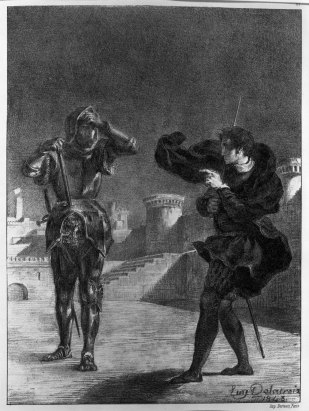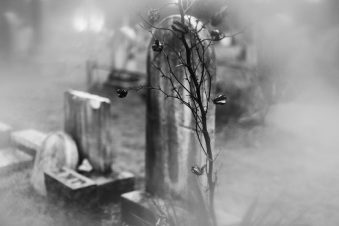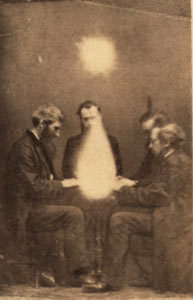
I have a particular interest in horror, probably because fear is such a primal response to things that are ‘unnatural’ or ‘unexplained’. I like explanations, I like facts and I like scientific proof. What I don’t like is Derek Acorah on Most Haunted trying to convince me that a dog is looking at the ghost of an ape before Acorah himself then becomes ‘possessed’ by it.
All cultures have ghost stories and chain-rattling apparitions go all the way back to Pliny the Younger who thought that his house was being haunted by an old man in the first century AD. The first poltergeist, or ‘noisy ghost’, was reported in Germany in 856 AD, whilst the Victorian era saw a rise in mediums and contact with the dead. It also saw a rise in scientific exploration to try and prise apart the secrets of the paranormal, such as the manifestation of ectoplasm (a mixture of cheesecloth and egg white mostly) and table rapping. The most notorious debunker was Harry Price, famous for his investigations of Borley Rectory in Essex, which was supposedly haunted by a nun who had an affair with a monk and then was bricked up alive. According to the final report produced later after the house burnt down, the hauntings were a mixture of rats, an oddly-shaped house affecting the acoustics and fraudulent activity both by the people living there and Price himself.
So are all ghostly goings-on a mixture of ill-fitting floorboards and people making it all up? Several people that I know have seen ghosts and I believe that they believe they saw something. Scientists have come up with a range of theories, but as I found out, this is a lot more common than you may think.
It’s behind you
In 2014, an experiment was undertaken in Switzerland to see what happened when a person’s movement and brain signals were deliberately put out of sync. They actually managed to ‘create’ the first ghost in a lab. Blindfolded participants were asked to control a robotic arm positioned behind them, so when they pushed it forward it touched their back. The signal was then delayed by 500 milliseconds, which is when shit got weird, to not quote any of the scientists there. Suddenly, the participants felt as though they were being watched and touched by a ghost, and some people reported up to four other presences in the room with them. Two even asked to stop the experiment they found it that disturbing. The researchers said that this shows that ghosts are ‘probably just an illusion created by the mind when it momentarily loses track of the body’s location because of illness, exertion or stress’. So no wonder people are always seeing ghosts when they’re running around creepy houses in the middle of the night.
Or just in your head

I thought it would be interesting to find out whether an in-depth, rigorously scientific experiment had ever been undertaken in a haunted location to work out precisely what is was that caused people to think that they have managed to take a picture of Anne Boleyn’s ghostly hand photobombing their holiday snaps.
There has been some research, but it’s a fairly esoteric area of science, with the majority of work taking place on the psychological or sociological side. Back in 2004 however, a haunted bedroom in Muncaster Castle in the Lake District was investigated and then written up in a fantastically named paper ‘Sleeping with the entity‘. The researchers were looking into magnetic fields and whether this was causing people to hear children crying, see fleeting shadows and experience ‘periodic feelings of severe foreboding’. Results did show that there were magnetic fields fluctuating in the area of the bed, which could account for the feelings of dread and presences in the room. As this article explains, magnetic fields have been shown to cause dizziness and hallucinations, whilst cold spots could be down to reduced humidity (or a drafty chimney) and low frequency sound waves can vibrate the eye, making us see things which aren’t there.
Trust me, I’m a scientist

One thing I have learnt from writing this however is don’t believe scientists, because they’ll lie to you just to see what you’ll do.
One of the most famous haunted buildings in England is Hampton Court Palace, which has another of Henry VIII’s wives wandering the Haunted Gallery, this time Catherine Howard, and a servant of the court nicknamed the Grey Lady, who apparently took exception to her tomb being moved. A while back a ghost was also caught on CCTV, and is now known affectionately as Skeletor.
To test the impact of suggestiveness as well as previous belief and magnetic interference, a group of researchers led by Dr Richard Wiseman (who in addition to being a paranormal explorer, is also a professional magician, as if he wasn’t cool enough) decided to do a higher-tech version at the palace of what Harry Price tried to do at Borley Rectory, but presumably without resorting to hiding behind the curtains and making ghost noises.
600 visitors were surveyed on their beliefs about ghosts and past experiences that they felt were due to ghosts, and then they walked around the most haunted areas of Hampton Court and reported anything strange. Half of the group were told that there had been a recent increase in unusual phenomena, whilst the other half were told the opposite. Perhaps unsurprisingly, believers were far more likely to report phenomena, as were those told that there had been more hauntings recently.
We tend to believe what we are told, and, as Wiseman points out, if you already know that somewhere is supposed to be haunted, you’re more likely to experience this yourself. This was tested by yet more lying scientists who removed prior expectation by using an old cinema and told half a group it was haunted, and the other half that it was merely being renovated and they wanted their impressions on how it felt. As expected, significantly more paranormal experiences were reported by the first group.
Magnetic fluctuations were also found in the more haunted areas at Hampton Court, but whether this contributed to the phenomena wasn’t clear enough to be separated from suggestion and, what I will be moving on to next, belief.
I believe!

A key focus in paranormal research is belief, but I found out that people having various paranormal experiences was more common than I realised.
One large-scale survey undertaken in 2009 surveyed 4096 adults in Great Britain and found that 37% had experienced some sort of paranormal activity, such as telepathy, extrasensory perception, precognition, mystical experiences and contact with the dead. Are these down to ‘fictitious products of tradition’ – myths and folklore? Or do a lot of people have these experiences and then build a story to explain it? Are believers stereotypical UFO fanatics with conspiracy theories about Area 51, or actually quite a large percentage of the population experiencing things which come down to a mixture of social and psychological factors?
In 1985 a researcher looked at the data from a range of surveys on paranormal belief in Western Europe and the US and found a ‘widespread belief in psychic phenomena’, with more than half of respondents from Great Britain, Iceland and the US reporting at least one psychic event, including 23% of people in Western Europe reporting contact with the dead.
The 2009 survey looked into who would be most likely to have a paranormal experience and found, as have previous studies, that women report it far more. Why though is difficult to prove. Women have been shown to be more likely involved in religious communities or New Age practices and complementary medicine, so the link may lie with interpersonal networks and lifestyle choice say the authors.
It was also found that middle-aged people are more likely to report experiences, but they weren’t asked at what point in their lives it had happened. The author theorises that this could be down to a general increase in reflecting on one’s mortality and experiencing ‘wake up calls’ such as changes in long-term relationships, serious illness or deaths.
Interestingly, it was also found that people living in the South West of England were more likely to experience phenomena, at 37.6%, followed by the South East. The North West had the lowest percentages of reported experiences, with just 6.7% of people reporting contact with the dead compared to 10.4% nationally. The authors suggest that this is down to there being more cultural and historical influences in the South West, such as Arthurian myths, Stonehenge and Glastonbury. I personally think that North Westerners are far too sensible to go around taking dodgy pictures graveyards and claiming that it’s a Pendle Witch.
Essentially, if you’re a woman living in Cornwall heading into middle age and you enjoy a herbal tea, it’s going to get weird I’m afraid. I’d particularly stay away from Jamaica Inn if I were you unless you want to hear some disembodied hooves or ‘foreign tongues’ being spoken in the darkness.
So you’ve seen a ghost (You’re a terrible person)
So what causes us to see ghosts? And does it really matter if somebody thinks that they’re a bit psychic? The general scientific consensus seems to be it’s all down to prior belief, suggestiveness, group hysteria, magnetic fluctuations and things vibrating our eyeballs. This report from the US National Science Foundation however is pretty brutal, saying that belief in the paranormal is linked to ‘an inability to make well-informed decisions’, ‘the encouragement of a “something for nothing” mentality’, and ‘a diversion of resources that might have been spent on more productive and worthwhile activities (for example, solving society’s serious problems)’. Ouch.
Whether or not you think that believing that you have seen a ghost means that you’re a useless member of society, none of this is obviously going to keep a good ghost story down, especially if it involves the spectre of a wronged woman luring you into a castle’s ruins or a headless nun decapitated by ‘a mad trapper’ who then ran off into the woods with it.
But why all the female ghosts? To be explored in my next blog post perhaps. There’s a strange sense of precognition coming over me…